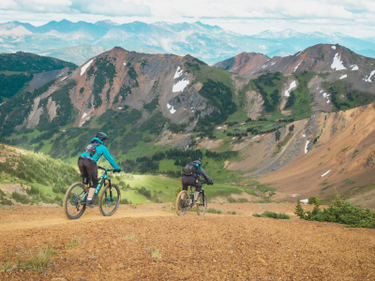How to Layer for the Mountains
There’s nothing worse than being cold, especially when you’re in remote areas far from the comfort of cell reception and overnight shipping. The best way to stay warm for any outdoor activity where you’ll be moving around a lot is layering. You may start uphill in a T-shirt, drenched in sweat in 20 degrees, then later on need an insulating layer and a shell to keep dry, as all of sudden 20 degrees truly feels like 20 degrees. Therefore, a strategic layering system of quality, lightweight, versatile pieces is paramount.
Let’s start from the top.
Head:
- Beanie or insulated headband. This doesn’t have to be too fancy but remember that it needs to be able to fit under a helmet.
Backpacks:
- Daypack. This is ideal if out skiing, going on a day hike, etc. The type of pack you need is all dependent upon the amount of volume you take with you. Something like a day hike that doesn’t demand a sleeping bag and stove top can be frameless and lightweight. Enough to fit a few layers, some snacks, and camera.
- Multi Day pack. There are two types of multi day packs: internal frame, and external frame. These can be tricky and range from a moderate size to fit sleeping bags and essentials to quite large backpacks that could fit an entire camp kitchen for five! If you’re not sure what size you need, talk to a dealer, outfitter, or us :)
Upper Body:
- Short sleeve t-shirt. This is one of the most overlooked items when it’s a newbie’s first time, but incredibly necessary when trekking up an ascent and pouring sweat, or on a glacier with the sun beating down. Look for one with sweat wicking qualities that’s lightweight and, ideally, UV protected.
- Long sleeve baselayer. Unless you’re going on a major summiting expedition, stick with 120-200g weight for this piece. While merino wool still leads the way as fabric choice, plenty of brands are using new materials with antimicrobial properties for freshness longevity during longer trips.
- Wind resistant soft shell. The point of this piece is to protect you from wind and provide a level of warmth, but not too much warmth that you overheat. Think of this piece as a transitional midlayer whose primary purpose is to create a mild buffer between the wind and your baselayer. 300-500g is a good weight for this.
- Insulated thermal jacket. This jacket is critical and designed to be the finishing piece on dry days. It should have a hood, since its primary purpose is to keep you warm. Don’t worry about buying a 600g+ expedition jacket unless you plan on summiting Mont Blanc.
- Waterproof shell. While no one likes to be wet, you definitely don’t want to be wet AND cold. By adding a waterproof layer over all of the above, your layering system will not be compromised and you can continue to stay dry and warm. While it doesn’t need to be heavy, it needs to be waterproof and breathable, and able to fit over your other layers comfortably.
Lower Body:
- Baselayer. While perhaps less important than a baselayer top, your long johns can definitely be a staple in your winter layering. Look for pieces that are lightweight, moisture wicking, and breathable.
- Softshell or Hardshell Pant. The preference here varies person to person. While each has their own advantages and disadvantages, if you see yourself going to be in an area with a high chance of precipitation, definitely opt for the hardshell. It’s waterproof coverage will be your best bet for protection.
- Overpant. This a great option to have handy in your pack that you hopefully may never need, but when you do you’ll be glad you packed them. These pants are fairly light and have full length zippers down the sides so you can easily take them on and off. They provide an extra layer of protection from wind and water. Look for a gore-tex type shell.
Accessories:
- Socks. You’ll want two types of socks here, a thinner pair and a thick wool pair. Both pairs should fit well and not move around inside your boot. There may be occasions where you want the thinner pair and thick wool pair, or just the thick wool pair.
- Sunglasses. Snow blind is real! Make sure to look for some that have UV protection and stay on if you were to bend over to pick up something. They don’t have to be super fancy, but make sure you have them.
- Gloves. Dexterity is critical when in the mountains. You must be able to get things from your pack, set up gear, and move your fingers about with ease. Gloves are also largely personal preference as each person’s body temperature is regulated differently. Some people can use a liner with a heavier neoprene glove and be fine while others require a liner plus the heaviest glove made.
Pro tip: Make sure to try them on and practice opening your pack a few times, zipping up coats, and see how easily you can move in them.
And there you have it! We hope you enjoyed our expert recommendations and should now be an expert yourself when it comes to layering for all of your adventures to come. And remember, you can score Black Friday deals all day, every day at Out&Back. Who said the best adventure can’t come at the best cost?


